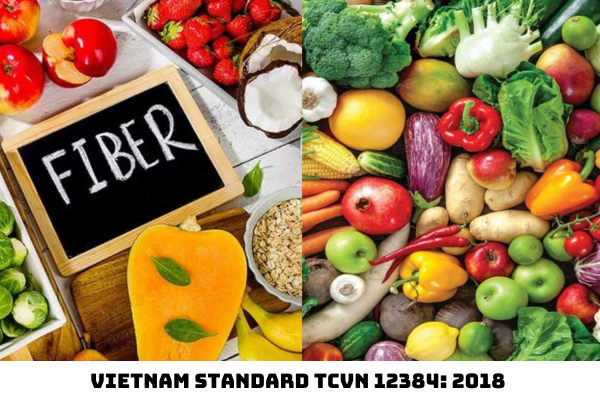What is the scope of application of Vietnam Standard TCVN 12384: 2018? What are the principles specified in Vietnam Standard TCVN 12384: 2018?
What is the scope of application of Vietnam Standard TCVN 12384: 2018?
Vietnam Standard TCVN 12384: 2018 is formulated based on reference AOAC 2011.25 - Insoluble, Soluble, and Total Dietary Fiber in Foods. Enzymatic-Gravimetric- Liquid Chromatography;
Vietnam Standard TCVN 12384: 2018 is compiled by the National Technical Committee of TCVN/TC/F13 on Analysis and sampling methods, appraised by the Directorate for Standards, Metrology and Quality, and announced by the Ministry of Science and Technology.
The scope of application of Vietnam Standard TCVN 12384: 2018 is as follows:
Vietnam Standard TCVN 12384: 2018 specifies the Enzymatic-gravimetric-liquid chromatographic method for the determination of the content of insoluble dietary fiber (IDF), soluble dietary fiber (SDF), and total dietary fiber (TDF) in food including stable starch (RS) and non-degradable oligosaccharides and polysaccharides that can be dissolved in water mixtures: ancol has a polymerization index (DP) ≥ 3.
The results of the interlaboratory study are set out in Appendix A.

What are the principles specified in Vietnam Standard TCVN 12384: 2018?
In Section 2 of Vietnam Standard TCVN 12384: 2018, the following principles are outlined:
Two parts of the repeat specimen were incubated with pancreatic α-amylase and amyloglucosidase (AMG) for 16 hours at 37 °C in a tightly closed 250 ml jar, shaken vigorously enough to maintain a continuous suspension.
In this step, unstable starch is dissolved and hydrolyzed into glucose and maltose due to the combined action of the two enzymes. The reaction is halted by pH adjustment and mild heating. The protein in the sample is then broken down by the protease.
To determine IDF, the decomposition fluid is filtered and IDF is determined by the mass method after adjusting proteins or ash in sediment.
To determine whether the dietary fiber is soluble in water, but insoluble in a mixture of water: alcol (SDFP) was added to the IDF filtrate; filtration was to retain precipitated SDFP and determination by mass method after correction of proteins or ash present in the precipitate.
Water-soluble dietary fibers: non-precipitated almonds (SDFS) are obtained by condensing the filtrate, deionizing with ion exchange resins, concentrating and quantifying by liquid chromatography (LC), or by concentrating the filtrate followed by simultaneous deionization and quantification by LC.
What is the method of determining soluble dietary fiber in water under Vietnam Standard TCVN 12384: 2018?
Based on the provisions of Clause 7.4 of Vietnam Standard TCVN 12384: 2018, the method of determining soluble dietary fiber in water in Vietnam is as follows:
(1) Generating of water-soluble SDFP precipitation
For each sample filtration solution, add the remaining water from the IDF transfer and coat the IDF [see 7.3(b)] or add the amount of water, if necessary to bring the total volume to exactly 70 ml, then add 279 ml ethanol 95% (volume) or IMS(3.1) (measured at room temperature), preheated to 60°C and mixed thoroughly.
Precipitate SDFP at room temperature for 60 min.
(2) Filter mode settings
Weigh the cup containing Celite (see 4.3), accurate to 0.1 mg; Wet and redistribute Celite in cups, using 15 ml of 78% ethanol (volume) or IMS (3.2) from the sink; Use a suction tool to transfer the Celite to the cup; Remove the dialysate.
(3) Filtering
Use the vacuum to filter the precipitated SDFP [7.4(a)] from the upper floating section through the crucible; Use a sink with ethanol 78% (volume) or IMS (3.2), transfer all remaining particles on the side of the cup; Retain filtrate and rinse [7.4(d)] for determination of SDFS.
(4) Washing
Use a vacuum to wash the residue in a row with parts of a volume of 15 ml as follows: two parts of ethanol 78 % (volume) or IMS (3.2); then two parts of ethanol 95 % (volume) or IMS (3.1); Finally, there are two acetone parts (3.3). Combined with the filtration fluid of the filtration step [7.4 (c)].
(5) Drying of cups containing residue overnight in drying cabinet (4.9) at 105°C.
(6) Cool in a desiccant (4.11) for about 1 h. The cup scale contains the remaining fiber and Celite, to be accurate to 0.1 mg. Subtract the empty cup mass from this mass (i.e., the mass of the calcined cup and dry Celite) to obtain the residue mass.
(7) Determination of protein and ash content
The residue of one of the two cups is used for protein analysis and the residue of the second cup is used for ash analysis.
Perform protein analysis using the Kjeldahl method or burning.
Be careful when using a combustion analyzer used to analyze proteins in the residue;
Celite vaporization from the sample can clog the transmission line of the device. Use a factor of 6.25 for all cases to calculate the number of milligrams of protein. To analyze the ash, calcined the residue of the second cup for 5 h at 525 °C. Cool in a desiccant (4.11) and weigh exactly to 0.1 mg. Subtract the mass of the cup and Celite from this mass to determine the ash.
(8) Filtration for Recovery, Deionization and LC Analysis, specifically:
Transfer the displacement 7.4(c) of the specimen to a 1 L rotary vessel and concentrate with a rotary machine (4.28) to dry at 50 °C.
Dissolve the residue in 10 ml of deionized water (3.7) and transfer to an airtight container, store at 4 °C if there is an overnight storage option before deionization.
When done next, half of the filtrate is concentrated to dry and dissolved again in 5 ml of water. This gave the same result but halved the time she filmed. For deionization by manual method, proceed according to 7.5.6.
To simultaneously deionize and quantify LC, proceed according to 7.5.7.
LawNet